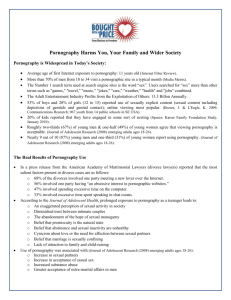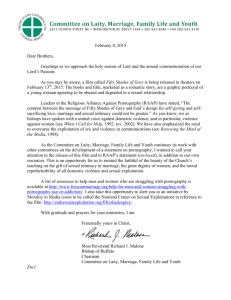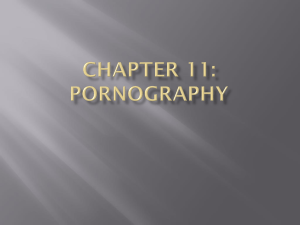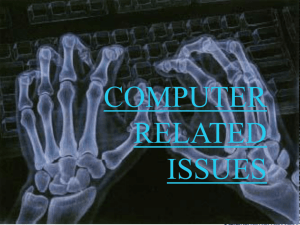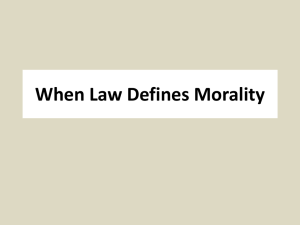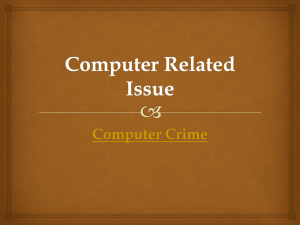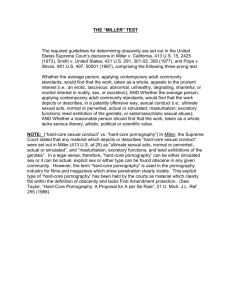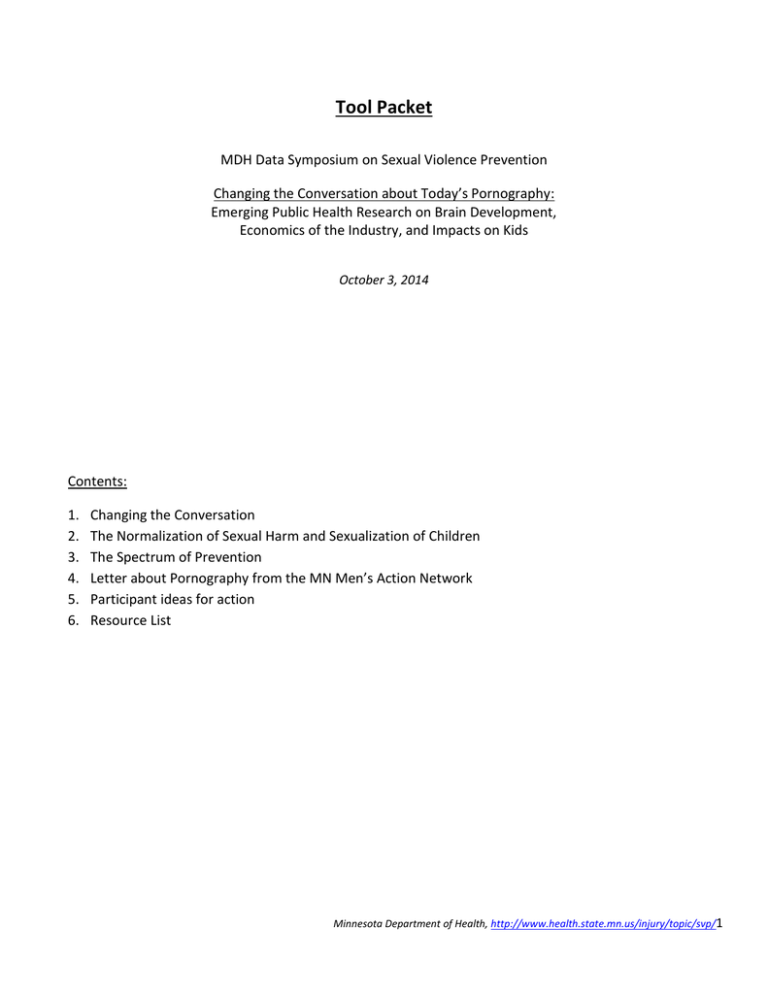
Tool Packet
MDH Data Symposium on Sexual Violence Prevention
Changing the Conversation about Today’s Pornography:
Emerging Public Health Research on Brain Development,
Economics of the Industry, and Impacts on Kids
October 3, 2014
Contents:
1.
2.
3.
4.
5.
6.
Changing the Conversation
The Normalization of Sexual Harm and Sexualization of Children
The Spectrum of Prevention
Letter about Pornography from the MN Men’s Action Network
Participant ideas for action
Resource List
Minnesota Department of Health, http://www.health.state.mn.us/injury/topic/svp/1
Changing the Conversation
We titled this symposium “Changing the Conversation” to not only inspire you to have conversations about this issue,
but also in reference to the idea that we need to change dominant societal beliefs about pornography by talking about
the harms. At this symposium, we will learn about the harms. How can you use what you learn today to start changing
conversations? Below are a few tips, but chart your own path using your unique skills and creativity.
Understanding the harms:
Most people focus on the impacts of pornography for viewers, which is important, but that’s just one area of harm:
Who is in it and what are their stories?
What effects can it have for their families, partners,
and friends?
How is it produced/made?
What effects can it have on social norms?
What occurs in it and what words are used?
In what societal context does it exist?
Where is it seen?
What is its meaning?
How is it used?
Who is profiting from it at whose expense?
What effects can it have for viewers?
The reality about pornography:
Impacts
personal
liberty
Contributes
to sexual
violence &
exploitation
Victimizes and
exploits the
actors
Shapes sexual
desire and
behavior
Adult porn
and child
porn are
connected
Educating
kids is not
enough
Together, we
can effect
change and
make an
impact
Changing Conversations: Where and with Whom
Consider beginning your conversations with co-workers, and together work to change policies and practices in your
own workplace
Talk to business owners and service providers, community members and community organizations
Talk to policy leaders at the local and state level
Include information about this issue in your presentations and speeches
Get creative with social media!
Changing Conversations: How
Talk about the harms (see pages 3-4 of this packet for examples of harms, and page 7 for a letter about harms)
Use words with deeper meaning to make your point: such as an appeal to equality and human rights
Utilize resources such as Ted Talks or brief videos such as Fight the New Drug, if you find such media helpful
Share your own story and ask people to share their stories; sometimes these are more powerful than statistics
Changing Conversations: Reminders
While pornography alone didn’t create the problem of sexual violence, it contributes to the problem. It is one of
many risk factors that contribute to sexual violence, but it is an important one.
Pornography perpetuates harmful societal beliefs and attitudes not only against women/girls, but also against
racial/ethnic minority groups, LGBTQ people and other marginalized groups.
Don’t blame people who have been used as actors in pornography, as they are victims of the industry
This is a hard topic for people to talk about
Pushback is expected
Minnesota Department of Health, http://www.health.state.mn.us/injury/topic/svp/2
The Normalization of Sexual Harm and the Sexualization of Children
(Document prepared by the Media Action Team of the Sexual Violence Prevention Program http://www.health.state.mn.us/svp/)
“Little girls are being groomed into passively accepting their place as objects in our pornified culture,
and boys are being taught exploitive and abusive sexual scripts.”
-- Cordelia Anderson, Founder, Sensibilities Prevention Services
As a society, we are inundated with images and messages that are…
1) Sexualizing minors and children at younger and younger ages.
2) Portraying sexual exploitation and sexual violence as normal.
These messages are everywhere -- from TV shows and commercials, to movies and music, billboards and bus shelters,
even products designed for and marketed to kids.
Harmful to girls and boys, this saturation of sexual messaging…
Creates the perception that a child’s self-worth is tied to his or her sexuality. This, in turn:
Degrades girls’ emotional and mental wellbeing: Adolescent girls who have a more objectified relationship
with their bodies are more likely to experience depression and have low self-esteem.1
Decreases girls’ cognitive performance: Numerous studies have shown that self-objectification detracts
from a girl’s ability to concentrate and focus her attention, leading to poorer performance in math, logical
reasoning and spatial skills.2
Limits girls’ physical performance: One study found that the greater the extent to which girls viewed their
bodies as objects and were concerned about appearance the poorer their performance throwing a softball.3
Teaches boys to view and treat girls as sexual objects: Research carried out in a dozen countries found that
boys exposed to porn are more likely to indulge in casual sex and less likely to form successful relationships
as an adult.4 It also found that young boys exposed to pornography are more inclined to believe that there is
nothing wrong with pinning down or sexually harassing a girl.5
Impedes healthy and responsible sexuality: Several studies have found links between early exposure to
sexually explicit media and earlier sex as a teen and increases in teen pregnancy.6
Condones and creates an appetite for sexual harassment and abuse.
Watching is like acting to the brain: Studies of mirror cells in the brain show that brain circuits fire in the
same way when we observe someone doing something as when we actually do it.7 Repeatedly viewing
images of sexual violence desensitizes people to the awful nature of those acts.
Exposure to pornography and the committing of sexual violence are correlated: Numerous studies have
found that boys exposed to sexually explicit media have higher rates of sexual harassment perpetration
(even controlling for other factors that could have contributed to this difference – like demographics). 8
Victimization of underage girls is growing: Research conducted by the Shapiro Group on adolescent girls in
the sex trade suggests that in Minnesota, 124 girls under age 18 were commercially sexually exploited via
internet classified ads or escort services in a single month, August, 2010.9
What is normalization?
Normalization is the process by which an idea or behavior goes from clearly problematic to an accepted part of
societal culture.10
There is a difference between sexy and sexually exploitive.
Harmful or exploitive images or messages depict people as sexual objects, valuable primarily for others’ use.
Minnesota Department of Health, http://www.health.state.mn.us/injury/topic/svp/3
Healthy images present sexuality with a sense of caring, connectedness, and sexual respect. It suggests intimacy
as one part of a relationship, rather than all of it.
Admittedly, there is a vast spectrum of sexual content and lines are difficult to draw.
Is Miley Cyrus (Disney’s Hannah Montana) pole dancing at the MTV Teen Music awards just showing some new
moves or role-modeling objectified behavior?
Is it significant that the main character in the new kids’ movie “Hop” stops to visit Hugh Hefner at the Playboy
Mansion on his journey to becoming the Easter bunny?
Do children’s push-up bras or “Who needs a credit card” underwear cross a line?
The constant pushing of boundaries has changed our collective sense of what is acceptable.
Attractive has become Sexy has become Objectified has become Pornified
This is the new normal’s message:
Sexual exploitation is just part of life.
If you are a woman, you should strive to be seen as a sexual object and treated as such.
If you are a man, you are to act as if a woman’s only worth to you is the sexual encounter she can provide, or you
can take.
It is a message that, when we say it out loud, we soundly reject.
Sexual violence is not inevitable. It is preventable.
Thank you for your help pushing back against the pervasiveness of these toxic messages.
________________________________________________________________________
1,2,3 Report of the American Psychological Association Task Force on the Sexualization of Girls. 2007. pp. 22-25.
4 Harms of Pornography Exposure Among Children & Young People. Australian Research Centre in Sex, Health & Society.
5 Chandra et al Longitudinal Survey of Youth, Pediatrics 122, No. 5, 2008, pp. 1047-1054. Children’s Hospital Boston Study, presented at the Pediatric Academic
Societies, May 4, 2009.
6 Shane W. Kraus, Brenda Russell. Early sexual experiences: the role of internet access and sexually explicit material. CyberPsychology & Behavior. April 2008, 11 (2):
162-168.
7 Gallese, V., Fadiga, L., Fogassi, L., and Rizzolatti, G. (1996). Action recognition in the premotor cortex. Brain, 119, 593-609.
8 Bonino, S., Ciairano, S. Rabaglietti, E. & Cattelino, E. (2006). Use of pornography and self-reported engagement in sexual violence among adolescents. European
Journal of Developmental Psychology, 3(3), 265-268. Brown, J., & L’Engle, K. (2009). X-Rated: Sexual attitudes and behaviors associated with U.S. early adolescents’
exposure to sexually explicit media. Communication Research, 36(1), 129-151. Flood, M. (2009). The harms of pornography exposure among children and young
people. Child Abuse Review, 18, 384-400.
9 Adolescent Girls in the United States Sex Trade: Tracking Study Results for August, 2010. Prepared by The Schapiro Group.
10 Normalization of Sexual Harm Webinar, Cordelia Anderson & Dr. Sharon Cooper, 2006, www.cordeliaanderson.com.
Minnesota Department of Health, http://www.health.state.mn.us/injury/topic/svp/4
The Spectrum of Prevention
In addition to changing conversations, what are the various types of actions that we need to take in order to address the
harms of pornography? The Spectrum of Prevention framework1 suggests that a variety of levels of actions are needed
in order to address this issue (Cohen et al., 1999). The framework describes six levels at which actions should occur.
Prevention Institute www.preventioninstitute.org
Descriptions of the Levels of the Spectrum
1. Strengthening Individual Knowledge and Skills: enhancing an individual’s capability of
preventing violence and promoting safety.
2. Promoting Community Education: reaching groups of people with information and
resources to prevent violence and promote safety.
3. Educating Providers: informing providers who will transmit skills and knowledge to
others and model positive norms.
4. Fostering Coalitions and Networks: bringing together groups and individuals for
broader goals and greater impact.
5. Changing Organizational Practices: adopting regulations and shaping norms to prevent
violence and improve safety.
6. Influencing Policy and Legislation: enacting laws and policies that support healthy
community norms and a violence-free society.
1
Cohen, L. & Swift, S. (1999). The spectrum of prevention: developing a comprehensive approach to injury prevention. Injury Prevention, 5, 203-207.
Minnesota Department of Health, http://www.health.state.mn.us/injury/topic/svp/5
Using the Spectrum of Prevention to Take Action: Hotel Example
Following is an example of actions related to one type of establishment that we all can use- hotels/motels. Use this
example to think- what other types of institutions and establishments might have areas for policy and practice change
around pornography, sexual exploitation, and sexual violence, and how can I use the spectrum of prevention in
developing ways to take action.
Level 1: Strengthening Individual Knowledge and Skills
Example: Meet with hotel owners to educate them about the harms of pornography. Tell them why you care, and that
they can be a part of the solution. Ask them to make a commitment to equality and non-violence by changing their
policies and practices.
Level 2: Promoting Community Education
Example: Partner with your local sexual violence/domestic violence advocacy organization to offer presentations to
educate community members about the harms of pornography and to ask them to work with hotels/motels about this
issue.
Level 3: Educating Providers
Example: Partner with your local public health department and your local sexual violence/domestic violence advocacy
organization to form an email listserv to share resources and conversation with organizations and institutions in your
area. Share ideas for how listserv members can educate hotel owners.
Level 4: Fostering Coalitions and Networks
Example: Work with local community organizations to build a community action team that focuses on addressing the
harms of pornography and ending sexual violence and exploitation. Invite hotel owners to join.
Level 5: Changing Organizational Practices
Example: Ask hotels to follow the example set by the Nordic Choice hotels by no longer offering pay-per-view
pornography, and instead replacing it with contemporary art. The idea is that pornography shouldn’t be an amenity that
hotels offer.
Level 6: Influencing Policy and Legislation
Example: Follow the example of Winona County and educate local institutions about passing a policy so that employees
will not be reimbursed for staying in hotels that offer pay-per-view pornography in hotel rooms, i.e., that offer
pornography as an amenity.
What examples can you come up with for each level?
What establishments and institutions besides hotels do you think are good places to focus on for changing policy
and practice?
As a place to start, consider changing policies and practices in your own workplace.
For more information on addressing pornography in hotels, check out “Clean Hotels” on the MNMAN webpage:
http://menaspeacemakers.org/programs/mnman/community/
Partnering and strategizing with others in your community, particularly your local public health offices and
sexual/domestic violence advocacy organizations, will increase your impact!
Minnesota Department of Health, http://www.health.state.mn.us/injury/topic/svp/6
Letter about Pornography from the MN Men’s Action Network
Gentlemen,
April is Sexual Assault Awareness Month (SAAM). The Women’s Foundation of Minnesota and the University of
Minnesota Humphrey School’s Center on Women and Public Policy released a 2012 report on the Status of Women and
Girls in Minnesota. In that report, they indicate that: “By mid-life, 33% of Minnesota women have experienced a rape
crime”.
We understand that if we are going to end sexual violence we need to address the environment in which boys are growing
into men (and boys) who abuse women (and girls). The overwhelming access to pornography and the mainstreaming of
porn into legitimate businesses is one environmental condition we believe contributes to this wide spread use of violence
against women, girls and boys. In a 2007 report, “Analyzing the Pornographic Text: Charting and Mapping Pornography
Through Content Analysis” , researchers Robert Woznitser, Ana Bridges, and Erica Scharrer detail their analysis of 50 films
randomly selected from the top 250 grossing pornographic films of that year. Here is a quick summary of their results.
50 films – 304 scenes
3,376 different acts of verbal and physical abuse utilizing the Perpetrator Action Target (PAT) scale. (This scale counts
as one act of aggression that which takes place when all three elements are present and unchanged. For example a
man (P) slaps (A) a woman (T) 10 times. Because each element is unchanged this constitutes one act of aggression.
If anyone of the three elements, P, A or T changes, another act of aggression is counted. For example, if another
man (P) enters the scene and slaps (A) the same woman (T) three times, those acts are counted as one event. So in
this example, the woman would have been slapped 13 times but the scale would have recorded it as two separate
incidents only).
11.5 acts of aggression per scene
0-128 acts per scene
Aggression rewarded 68% of the time
Neutral response to aggression 32% of the time
Discouraged 0% of the time
Positive sexual behavior represented just 10% of all actions
This research is the first to outline, with specificity, the extent to which violence and aggression is eroticized in
pornography. If you look at these statistics, it is clear that we are currently tying some of the most powerful pleasure
centers in a man’s body, heart, and mind … directly to women’s pain.
It is time men and boys, and the social institutions supporting this “industry”, stop the demand for pornography. Stop
taking our pleasure at women’s expense. Sexuality is a beautifully powerful experience that is currently being distorted
into sexually violent representations which eroticize domination, degradation and violence. There is over 30 years of
research making clear correlations between pornography use and increased aggression toward women and girls.
Sexually exploitative and violent material harms women and children and ultimately seriously impacts the boys and men
who view this material.
If you are currently using pornography, stop for 6 months and pay attention to how your thoughts of women and your
relationships with women transform. And then commit to a life based on the beauty and power of gender equality and
sexual respect. It will be worth it. And the women you care about will begin to live in a different world.
www.menaspeacemakers.org/programs/mnman - Chuck Derry at gvi@frontiernet.net or Ed Heisler at ed@menaspeacemakers.org
Minnesota Department of Health, http://www.health.state.mn.us/injury/topic/svp/7
Ideas for Action from Symposium Participants
Educate children and youth:
“Healthy sexuality and healthy relationships need to be
taught to people throughout different developmental
stages, both in and outside of schools”
“Need to build open dialogues with youth and children”
“Provide Circle talking piece time with kids”
“Model desired behaviors”
Advocacy around products:
“Talk with stores that sell playboy bunny costumes.”
“Plan to go to…Christian Bookstore and discuss the book
‘Pulling back the shades’ at a book club…”
“Have…petitions to address restaurants with sexualized
pictures on the walls and to address advertisements on tv”
“Boycott labels that advertise with porn”
Call to men:
“Need to focus on healthier gender roles and now on the
stereotypes that men are ‘strong’, ‘powerful’, and ‘in
control’ and that women need to be ‘submissive’…”
“Engage men in a counter campaign using the frame that
porn is men exploiting the sexuality of other men”
“Stand up against rape/sex jokes”
Work together:
“I now understand that I need to network and collaborate
with others in order to address this issue.”
Policy and practice changes:
“Petition for equitable songs at school dances”
“Working with [colleges] to get pornography included as an
addiction…”
“Change the use of language: pornography vs. child sexual
exploitation”
“Engage in policy work through MNCASA”
“Educate hotels”
“Increase focus on prevention and policy”
“Figure out what fits or is needed in my community to best
address this”
“Shows, movies, etc., ‘progress’ from acceptable to
unacceptable as we become ‘hooked’. Teach societal
awareness of how much we are manipulated by business.”
“Instead of placing blame on parents, blame society and
the industry”
“Have a ‘champions in health’ discussion for public health
people. Challenge local public health to make sexual
exploitation a part of their public health agenda”
“For sexual assault/domestic violence advocacy programs
to address porn in their services provided”
Hope- Imagining that things can be different:
“There is hope! Individuals need to take ownershipeducate ourselves, community.”
“I have a lot of hope for de-normalization of pornography
and changing cultural perceptions...”
Share this information:
“Talk to neighbors about the physical addiction of
pornography so we can keep our children safe.”
“Talk to youth pastor and my children”
“Want to tell my story- I’m a survivor”
Using art and creativity:
“I’m inspired to write an awareness book for my kids and
grandkids using life experiences.”
“Encourage young people to create and not just consume.
There are amazing, positive things happening in art and
internet communities around prevention…”
“Use creativity and art with school students. Use collective
imaginations to use art for…changing conversations.”
Teach a critical media awareness to kids and adults:
“Ask my kids about healthy relationships in tv and movies”
“Develop curriculum that addresses pornography, and
teaches people to ‘detect the lie’ inherent in it.”
Create awareness campaigns:
“Build an awareness campaign around ‘detect the lie’”
“Create public safety announcements about red flags,
featuring the [MN football teams].”
“Suggestions for changing cultural norms: de-sexualize
breastfeeding and breast cancer campaigns.”
“Bring to light the ugly of the industry- that it is exploitative
(sexually exploitative businesses) and unhuman.”
Speaking up:
“Talk about it…Violence thrives in silence.”
“Don’t be afraid to talk more about sensationalism and
how it shapes our relationships”
“Open dialogue: transparency, authenticity, refusing to
participate, normalize opposing language”
Participants also provided this critical feedback:
“…Don’t agree that all porn is harmful. Though agree that
much of what is available is harmful…What if we decrease
the production of abuse-laden porn that re-enforces
oppressive power dynamics and increase porn that
deconstructs those power structures?”
“The research, language, and discussions at this symposium
focused solely on heterosexual experiences and audiences
and it was not inclusive of LGBTQ people.”
“Conflicting understandings of sex work, prostitution,
trafficking, and pornography that do not acknowledge
consensual activity versus forced/coerced/etc. activity”
Minnesota Department of Health, http://www.health.state.mn.us/injury/topic/svp/8
Resource List
The following are resources suggested by various presenters, panelists, and members of the symposium planning team.
There are many resources available on this topic, and those included in this handout are only a few.
Disclaimer: Neither the State of Minnesota, nor any agency, officer, or employee of the State of Minnesota warrants the accuracy,
reliability, or timeliness of any of the resources listed on this handout, nor endorses any content, viewpoints, products, or services
linked to from this resource list, and shall not be held liable for any losses caused by reliance on the accuracy, reliability or timeliness
of such information.
Websites
Commercial Free Childhood- http://www.commercialfreechildhood.org Resources for parents
Fight the New Drug- http://www.fightthenewdrug.org/ Aids young people struggling with the effects of porn
Morality in Media/Porn Harms- http://pornharms.com/ Faith-based activism around pornography
Stop Porn Culture- http://stoppornculture.org/ Resources for challenging the industry and changing culture
Truce Teachers- http://www.truceteachers.org Resources for educators on counteracting media and marketing
Voice Male Magazine- http://voicemalemagazine.org/ Resources for men and boys
Your Brain on Porn- http://www.yourbrainonporn.com Resources on how porn can affect the brain
Internet Behavior Consulting- http://www.internetbehavior.com/ Research, resources, consultation, and training
Prostitution Research and Education http://prostitutionresearch.com/ Research and education
Videos
Adolescent brain meets high-speed internet porn, by Gary Wilson, available at http://www.yourbrainonporn.com
American Porn, from PBS Frontline http://www.pbs.org/wgbh/pages/frontline/shows/porn/
Getting off: Pornography and the end of masculinity, by Robert Jensen
https://www.youtube.com/watch?v=KbxBJf9UtWg
How porn creates the “John”, by Gail Dines https://www.youtube.com/watch?v=Ng172g_F8rM
Larry Cohen talks about the role of policy work in prevention : http://www.mncasa.org/prevention-videos
Online, offline, and over the line: Adolescents, sex, and the internet, by Elizabeth Griffin
http://www.youtube.com/watch?v=bRNTCVU_A3k
Presentation on pornography at Novia Scotia Women’s Summit, by Gail Dines https://www.youtube.com/watch?v=Z5iANEfQUU
Social Costs of Pornography conference, 2008, videos available at http://www.socialcostsofpornography.com
Ted Talk: The Great porn experiment- Gary Wilson
Ted Talk: Why I stopped watching porn – Ran Gavrieli
Various videos by the Media Education Foundation are available at http://www.mediaed.org
With impunity: Men and gender violence, available from http://www.educationforcriticalthinking.org
Books
Big Porn Inc.: Exposing the Harms of the Global Pornography Industry, ed. by Melinda Tankard Reist & Abigail Bray
Everyday Pornography, by Karen Boyle
Gender, Race, and Class in Media: A Critical Reader, by Gail Dines and Jean McMahon Humez
Getting Off: Pornography and the End of Masculinity, by Robert Jensen
In Harm's Way: The Pornography Civil Rights Hearings, by Catharina MacKinnon and Andrea Dworkin
Making Violence Sexy: Feminist Views on Pornography, ed. by Diane Russell
Not for Sale: Feminists Resisting Prostitution and Pornography, ed. by Christine Stark and Rebecca Whisnant
Pornified: How Pornography is Transforming Our Lives, Our Relationships, and Our Families, by Pamela Paul
Pornland: How Porn has Hijacked our Sexuality, by Gail Dines
Pornography and Civil Rights: A New Day for Women’s Equality, by Catharine MacKinnon and Andrea Dworkin
Pornography and Its Place in the Assessment and Treatment of Adolescents who have Sexually Abused, by David
Prescott and Siegi Schuler
Minnesota Department of Health, http://www.health.state.mn.us/injury/topic/svp/9
Pornography and Silence, by Susan Griffin
Pornography: Men Possessing Women, by Andrea Dworkin
Pornography: The Production and Consumption of Inequality, by Gail Dines
Racism in Pornography, by Diana Russell and Alice Mayall
So Sexy So Soon, by Diane Levin
In the Shadows of the Net, by Elizabeth Griffin, David Delmonico
Take Back the Night, ed. by Laura Lederer
The Impact of Pornography on Children, Youth, and Culture, by Cordelia Anderson
The Porn Trap: The Essential Guide to Overcoming Problems Caused by Pornography, by Wendy Maltz & Larry Maltz
The Porning of America: The Rise of Porn Culture, What it Means, and Where we Go From Here, by Saracino & Scott
The Price We Pay: The Case Against Racist Speech, Hate Propaganda, and Pornography, ed. by Lederer and Delgado
The Sexualization of Childhood, by Sharna Olfman
Transforming a Rape Culture, by Buchwald, Fletcher, & Roth
Understanding Children’s Sexual Behaviors: What’s Natural and Healthy, by Toni C. Johnson
Violence in the Lives of Black Women: Battered, Black, and Blue, by Carolyn West
Articles
Child pornography: Victims, victimizers, and victimization, from the National Children’s Advocacy Center
http://www.nationalcac.org/images/pdfs/CALiO/Bibliographies/porn-bib4.pdf
Eroticizing inequality: Technology, pornography, and young people, by Maree Crabb and David Corlett
http://apo.org.au/research/eroticising-inequality-technology-pornography-and-young-people
Health education’s role in framing pornography as a public health issue, by Paul Perrin et al.
http://ped.sagepub.com/content/15/1/11.abstract
Impact of exposure to sexually explicit and exploitative materials, from the National Coalition to Prevent Child Sexual
Abuse and Exploitation
http://www.preventtogether.org/Resources/Documents/Impact%20of%20Exposure%20to%20Sexually%20Explicit%
20and%20Exploitative%20Materials.pdf
Impact of media and technology on youth, from the National Coalition to Prevent Child Sexual Abuse and
Exploitation
http://www.preventtogether.org/Resources/Documents/Impact%20of%20Media%20and%20Technology%20on%20
Youth%202013.pdf
Pornography’s impact on children’s sexual development, by Cordelia Anderson in the Vermont parent’s Home
Companion, p. 104. http://www.pcavt.org/assets/files/PCAV%20Home%20Companion%203-2513%20for%20web.pdf
Producing abuse: Selling the harms of pornography, by Karen Boyle
http://www.sciencedirect.com/science/article/pii/S0277539511001348
Renting an organ for ten minutes: What tricks tell us about prostitution, pornography, and trafficking, by Melissa
Farley http://circlesperfect.files.wordpress.com/2008/10/farleyrentinganorgan11-06.pdf
Rethinking democracy: Legal challenges to pornography and sex inequality in Canada and the United States, by Max
Waltman http://prq.sagepub.com/content/63/1/218.abstract
The impact of cyber-porn on teens, an interview with Wendy Maltz, by Chris Mulligan
http://cybersolutionstoday.blogspot.com/2012/02/interview-with-wendy-maltz-lcsw-impact.html
The normalization of sexual harm and the sexualization of children, from the MN Department of Health
http://www.health.state.mn.us/injury/docs/Normalization_of_Sexual_Harm_Fact_Sheet.pdf
Trends in arrests for child pornography possession, 2012, from the Crimes Against Children Research Center
http://www.unh.edu/ccrc/pdf/CV269_Child%20Porn%20Possession%20Bulletin_4-13-12.pdf
Trends in arrests for child pornography production, 2012, from the Crimes Against Children Research Center
http://www.unh.edu/ccrc/pdf/CV270_Child%20Porn%20Production%20Bulletin_4-13-12.pdf
The slave and the porn star: sexual trafficking and pornography, by Laura Lederer, et al.
http://www.protectionproject.org/wp-content/uploads/2012/11/TPP-J-HR-Civ-Socy_Vol-5_2012-w-cover.pdf
Minnesota Department of Health, http://www.health.state.mn.us/injury/topic/svp/10
What is Pornography? By Michael Rea https://www3.nd.edu/~mrea/papers/What%20is%20Pornography.pdf
Why is it so hard to believe that media influence children and adolescents? By Victor Strasburger, et al.
http://pediatrics.aappublications.org/content/early/2014/02/25/peds.2013-2334.full.pdf
News
Experiment that convinced me online porn is the most pernicious threat facing children today, by Martin Daubney,
25 September, 2013 http://www.dailymail.co.uk
Interview with porn scholar [Gail Dines] on Tiger Woods sex scandal, by Jackson Katz, 8 June, 2010
Interview with porn scholar [Gail Dines] Part II: Business and Culture, by Jackson Katz, 18 August, 2010
http://www.huffingtonpost.com/
Jamie is 13 and hasn't even kissed a girl, but he's now on the Sex Offender Register after online porn warped his
mind, by John Woods, 25 April, 2012 http://www.dailymail.co.uk
Nordic hotel magnate replaces pay-tv porn channels with contemporary art, by Helen Russell, 25 August, 2013
http://www.theguardian.com/culture/2013/aug/25/nordic-hotel-petter-stordalen-pornography-tv
Schoolboy, 13, rapes his eight-year-old sister after watching porn on the X-Box because he 'wanted to try it out', by
Chris Pleasance, 5 February, 2014 http://www.dailymail.co.uk
The internet and pornography: Prime Minister calls for action, by The Rt Hon David Cameron MP, 22 July, 2013
https://www.gov.uk/government/speeches/the-internet-and-pornography-prime-minister-calls-for-action
Sexual Violence Prevention Resources
Centers for Disease Control- http://www.cdc.gov/violenceprevention/sexualviolence/
Gender Violence Institute- http://www.genderviolenceinstitute.org/
Jacob Wetterling Resource Center- http://www.gundersenhealth.org/ncptc/jacob-wetterling-resource-center
MDH Sexual Violence Prevention Program- http://www.health.state.mn.us/svp/
MDH Sexual Violence Prevention Network- http://www.health.state.mn.us/subscribe.html
Men as Peacemakers- http://menaspeacemakers.org/
MN Coalition Against Sexual Assault- http://www.mncasa.org/ and http://www.mncasa.org/hope
MN Communities Caring for Children- http://www.pcamn.org/
MN Human Trafficking Task Force- http://www.mnhttf.org/
MN Indian Women’s Sexual Assault Coalition- http://www.miwsac.org/
MN Men’s Action Network- http://menaspeacemakers.org/programs/mnman/community/
National Center for Missing and Exploited Children- http://www.missingkids.com/
National Coalition to Prevent Child Sexual Abuse and Exploitation- http://www.preventtogether.org/
National Sexual Violence Resource Center- http://www.nsvrc.org/
Prevent Connect- http://www.preventconnect.org/
Sexual violence and the spectrum of prevention: Towards a community solution- PDF available at:
http://www.preventioninstitute.org/index.php?option=com_jlibrary&view=article&id=97&Itemid=127
Sensibilities Prevention Services- http://www.cordeliaanderson.com
Researchers
There is a considerable amount of research on the harms of pornography, and this is just a short list. Copy and paste an
article title into an online search engine, in order to locate an abstract of the article.
Janis Wolak, Kimberly Mitchell, and David Finkelhor- Crimes Against Children Research Center at U of NH
Unwanted and wanted exposure to online pornography in a national sample of youth internet users, 2007.
Nature and dynamics of internet pornography exposure for youth, 2008.
Michele Ybarra- Center for Innovative Public Health Research
Exposure to internet pornography among children and adolescents: A national survey, 2005.
Linkages between Internet and other media violence with seriously violent behavior by youth, 2008.
Prevalence rates of male and female sexual violence perpetrators in a national sample of adolescents, 2013.
X‐rated material and perpetration of sexually aggressive behavior among children and adolescents: is there a link?, 2011.
Minnesota Department of Health, http://www.health.state.mn.us/injury/topic/svp/11
Donald Hilton- University of Texas at San Antonio
Pornography and addiction: A neuroscience perspective, 2011.
Pornography addiction: A supranormal stimulus considered in the context of neuroplasticity, 2013.
Elizabeth Morgan- Boise state University
Associations between young adults' use of sexually explicit materials and their sexual preferences, behaviors, and satisfaction
Michael Flood- University of Wollongong Australia
Exposure to pornography among youth in Australia, 2007.
Youth and pornography exposure in Australia, evidence on the extent of exposure and likely effects, 2003.
John Foubert- Oklahoma State University
Pornography viewing among fraternity men: Effects on bystander intervention, rape myth acceptance and behavioral intent to
commit sexual assault, 2011
Michael Seto- Mental Health Centre in Ontario
The role of porn in the etiology of sexual aggression, 2001.
The sexual arousal of rapists to rape stories: The contributions of sex, non-consent, and injury, 2012.
Neil Malamuth- University of California at Los Angeles
Pornography and sexual aggression: Are there reliable effects and can we understand them?, 2000.
Pornography, individual differences in risk and men's acceptance of violence against women in a representative sample, 2012.
The role of pornography in the context of general and specific risk factors, 2007.
Pornography and attitudes supporting violence against women: revisiting the relationship in non- experimental studies, 2010.
Pornography and teenagers: The importance of individual differences, 2005.
Robert Jensen- University of Texas at Austin
Pornography and sexual violence (VAWnet summary), 2004.
Drew Kingston- University of Ottawa
Pornography use and sexual aggression: the impact of frequency and type of pornography use on recidivism among sexual
offenders, 2008.
The importance of individual differences in pornography use: theoretical perspectives and implications for treating sexual
offenders, 2009.
Corita Grudzen- Mount Sinai School of Medicine
Comparison of the mental health of female adult film performers and other young women in California, 2011.
Jennifer A. Johnson-Virginia Commonwealth University
To catch a curious clicker: A social network analysis of the online pornography industry. In Karen Boyle, Ed., Everyday
Pornographies. Routledge (June 2010)
Mapping the Feminist Political Economy of the online commercial porn industry: a network approach, 2011.
Ana J. Bridges- University of Arkansas
Aggression and sexual behavior in best-selling pornography videos: A content analysis update, 2010.
Laura Carter Overstreet- Kennesaw State University
Splitting sexuality and disability: A content analysis and case study of internet pornography featuring a female wheelchair user
Gloria Cowan- affiliation unknown
Racism and sexism in interracial pornography: A content analysis, 1994.
Janet Shope- Goucher College
When words are not enough: The search for the effect of pornography on abused women, 2004.
Institute for Public Policy Research
Young people, sex, and relationships: The new norms, 2014.
Office of the Children’s Commissioner of England
Basically, porn is everywhere: A rapid evidence assessment on the effects that access and exposure to pornography has on
children and young people, 2013.
Minnesota Department of Health, http://www.health.state.mn.us/injury/topic/svp/12

